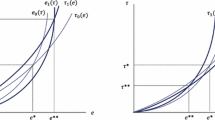Abstract
This paper analyses how progressive taxation schemes, implemented by local welfarist government, affect the segregative properties of endogenous jurisdiction formation, using a model where local jurisdictions produce a local public good, financed by a progressive tax on households’ wealth. A jurisdiction is composed of all the households that live in the same place. Local taxation parameters are determined so as to maximize a social welfare function. Households can “vote with their feet”, which means that they can choose to move to the jurisdiction that offers the package “tax - amount of public good” that provides the highest utility level. The main result of this article is the proof that the maximin criterion is more segregative than the utilitarian one. Consequently, it suggests that local governments can not simultaneously struggle against inequalities and segregation.

Similar content being viewed by others
Notes
To be perfectly rigorous, we should write “expenditure for the production of the local public good”. However, by integrating a public good production function, increasing with respect to the expenditure for the public good, into the utility function, the results obtained in this article would not be affected.
References
Bischoff K, Reardon SF (2014) Residential segregation by income, 1970–2009. Divers Disparities Am Enters New Century 43:1–44
Biswas R, Gravel N, Oddou R (2013) The segregative properties of endogenous jurisdiction formation with a welfarist Central Governmment. Soc Choice Welf 41:293–319
Demuynck T, Herings PJ-J, Saulle RD, Seel C (2019) The myopic stable set for social environments. Econometrica 87(1):111–138
Duncan OD, Duncan B (1955) A methodological analysis of segregation indexes. Am Sociol Rev 20(2):210–217
Gravel N, Oddou R (2014) The segregative properties of endogenous jurisdiction formation with a land market. J Public Econom 117:15–27
Gravel N, Thoron S (2007) Does endogeneous formation of jurisdictions lead to wealth stratification? J Econ Theory 132:569–583
Greenberg J (1977) Existence of an equilibrium with arbitrary tax schemes for financing local public goods. J Econ Theory 16:137–150
Greenberg J (1979) Consistent majority rules over compact sets of alternatives. Econometrica 47:627–636
Greenberg J (1983) Local public goods with mobility: Existence and optimality of a general equilibrium. J Econ Theory 16:137–150
Greenberg J, Weber S (1986) Strong tiebout equilibrium under restricted preferences domain. J Econ Theory 38:101–117
Jargowsky P (1996) Take the money and run: economic segregation in U.S. metropolitan areas. Am Sociol Rev 61:984–998
Jargowsky P, Kim J (2005) The gini coefficient and segregation on a continuous variable. National Poverty Center Working Paper 05-2
Kets W, Sandroni A (2019) A belief-based theory of homophily. Games Econ Behav 115(C):410–435
Massey DS (1978) On the measurement of segregation as a random variable. Am Sociol Rev 43(4):587–590
Milchtaich I, Winter E (2002) Stability and segregation in group formation. Games Econ Behav 38:318–346
Mill JS (1974) On liberty. Harmondsworth, Penguin, London. first publication, 1859
Oddou R (2016) The effect of congestion and spillovers on the segregative properties of endogenous jurisdiction structure formation. J Public Econ Theory 18(1):67–83
Oddou R (2016b) Redistribution and welfarism with running cost: why rawlsian and benthamite approaches lead to different outcomes? WP Economix, available online
Oddou R (2016) Segregative properties of endogenous jurisdictions formation à la tiebout: a survey of the literature. Revue d’economie Politique 126(3):357–378
Peski M, Szentes B (2013) Spontaneous discrimination. Am Econ Rev 103(6):2412–2436
Rawls J (1971) A theory of justice. Berknap Press of Harvard University Press, Cambridge
Rawls J (1982) Social unity and primary goods. In: Sen AK, Williams B (eds) Utilitarianism and beyond. Cambridge University Press, Cambridge
Reardon SF, Bischoff K (2016) The continuing increase in income segregation, 2007–2012. Stanford Center for Education Policy Analysis, Palo Alto. Accessed 20 June 2016
Reardon SF, Bischoff K, Owens A, Townsend JB (2018) Has income segregation really increased? Bias and bias correction in sample-based segregation estimates. Demography 55(6):2129–2160
Rhode PW, Strumpf KS (2003) A historical test of the tiebout hypothesis local heterogeneity from 1850 to 1990. Am Econ Rev 93:1648–1677
Samuelson PA (1954) The pure theory of public expenditure. Rev Econ Stat 64:387–389
Sidgwick H (1907) The methods of ethics, 7th edn. Oxford University Press, Oxford UK
Tammaru T, Marcinczak S, Aunap R, van Ham M, Janssen H (2020) Relationship between income inequality and residential segregation of socioeconomic groups. Reg Stud 54(4):450–461
Tiebout CM (1956) A pure theory of local expenditures. J Polit Econ 64:416–424
Watson T (2009) Inequality and the measurement of residential segregation by income in American neighborhoods. NBER Working Paper 14908
Watts M (2007) Developing spatial measures of residential segregation using kernel density estimation
Westhoff F (1977) Existence of equilibria in economies with a local public good. J Econ Theory 14:84–102
Author information
Authors and Affiliations
Corresponding author
Additional information
Publisher's Note
Springer Nature remains neutral with regard to jurisdictional claims in published maps and institutional affiliations.
Rights and permissions
Springer Nature or its licensor (e.g. a society or other partner) holds exclusive rights to this article under a publishing agreement with the author(s) or other rightsholder(s); author self-archiving of the accepted manuscript version of this article is solely governed by the terms of such publishing agreement and applicable law.
About this article
Cite this article
Oddou, R. Inequalities and segregation: can welfarist local governments struggle against both simultaneously?. Rev Econ Design 27, 849–866 (2023). https://doi.org/10.1007/s10058-023-00326-w
Received:
Accepted:
Published:
Issue Date:
DOI: https://doi.org/10.1007/s10058-023-00326-w




